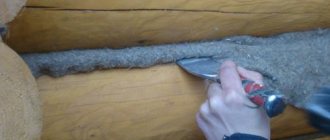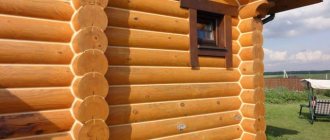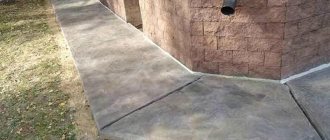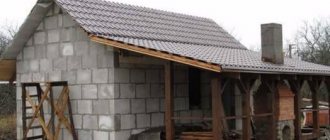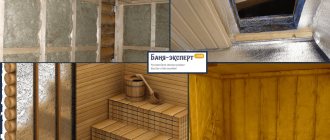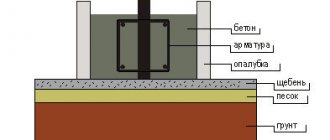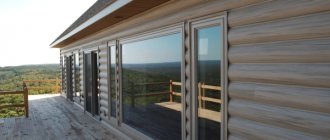- home
- Articles
- Sealing seams in a bathhouse - how to seal seams in a bathhouse
Every owner, when building a bathhouse, thinks about the question of how to cover up the seams in an already built bathhouse, which are very visible.
After all, no matter how tightly the timber is laid during construction, the seams still remain. And precious heat will escape through them, which will create uncomfortable conditions for visitors to the bathhouse. Consequently, in winter, heat in a timber bath can only be preserved if all joints, cracks and seams between the crowns are sealed. Moreover, the sealing of seams in the bathhouse should be carried out with special care.
Wood itself, due to its natural characteristics, can change volume and size. And in a bathhouse, due to constant temperature changes, this is especially noticeable, since cracks appear on the logs themselves, and gaps can form between the blocks. This leads to the fact that the bath structure becomes unprotected from wind and cold. But this problem is completely solvable, and insulation does not require large material costs. But insulation begins during the construction of the bathhouse, when the initial sealing and sealing of the bathhouse seams is carried out.
And then a completely natural question arises: “What should I use to seal the seams in the bathhouse and ensure its thermal insulation?” As sealants, you can use traditional materials that are usually used when laying crowns: tow, moss. Modern materials that provide thermal insulation in wooden structures are also suitable for sealing joints in the bathhouse.
What is sealant used for?
Sealing compounds are used to improve thermal insulation characteristics and eliminate various defects in natural wood coatings. Today, a variety of objects made of wood are very popular. They have not only advantages, but also disadvantages.
For example, as a result of exposure to precipitation and temperature changes, the elements of the log house become covered with cracks and shrink, which negatively affects the heat retention indicators. Gaps and seams require periodic sealing. Previously, short-lived improvised materials were used to solve the problem. But eventually the process of wood rotting began. Moisture led to mold and other related problems.
A much more effective solution is to use special modern sealants, which can be used to seal the crown joints of a log house. This technology is called “Warm seam”
Environmental friendliness comes first
When working with wood, every owner must not forget that this is a material of natural origin , so the question arises: is it worth using synthetic compounds that can negate the naturalness of a wooden house, if such methods of sealing gaps as using felt, tow and hemp. It’s hard to disagree with this, because for many centuries our grandfathers used natural materials that form an ideal combination with a wooden house. But you shouldn’t immediately write off acrylic sealants, which are just as environmentally friendly in composition as their natural counterparts.
Manufacturers take a very careful approach to the process of manufacturing seam sealants, observing strict safety requirements at every stage. As a result, they manage to create products that do not emit toxic substances and do not cause any harm to both humans and pets. Modern sealants shatter the opinions of individual consumers regarding the violation of wood structure by sealants. Therefore, in terms of environmental friendliness, there are no differences between caulk and sealants.
Composition requirements
Sealing compounds are versatile. They are used to eliminate defects in log houses, rafters, floor coverings, gaps and cracks in window frames, stair steps and other wooden elements.
High-quality wood sealant meets the following standards:
- resistance to sudden changes in temperature, direct sun and precipitation;
- plasticity and performance of its functions when seams are enlarged;
- high-quality grip on wood;
- natural shade;
- water-repellent properties that prevent the development of mold and mildew;
- long service life.
Let's support domestic producers
If we analyze the sealant market, then, traditionally, products from domestic manufacturers will be more attractive due to their low cost. You can buy one package of Russian sealant for 350 rubles. for 1 kg. As for American analogues, they cost about 3 times more. This should not be surprising, since this price includes customs duties, transportation costs and unreasonably inflated trade margins.
Domestic manufacturers use American and German polymers to produce sealant In addition, we should not forget that Russian sealants were initially created for use in harsh Russian conditions. Therefore, it is difficult to name at least one good reason to give preference to foreign products rather than high-quality sealants from Russian companies.
Types of sealing compounds
Restoration of seams is carried out using household or professional means. They differ in composition and cost. Professional sealants are much more expensive and not as easy to work with as with household compounds, so you will need some experience. Household sealing compounds are easy to use and are designed for use by ordinary housewives.
Before purchasing a sealant, you must carefully read the information about the selected product indicated on the tube. Colored sealants are available for sale, which are used in cases where the surface is not planned to be painted after the product has dried. Manufacturers also offer white sealing compounds, which are later painted. They are well suited for removing defects in white window frames and doors.
Processing of natural wood elements is usually carried out using silicone, acrylic and polyurethane sealants. Manufacturers also offer thiokol and bitumen compositions.
Non-hardening solutions in the form of mastic, which are sold in special bags, are ideal for outdoor work. These products contain silicone components.
Bituminous sealants are a good solution for repairing cracks in tiles and eliminating imperfections in walls. These products contain rubber and are only available in black.
Universal solutions that can be used for various interior jobs also deserve attention. Such pastes provide reliable protection against drafts.
What should I use to insulate external seams?
The outer seams need to be insulated first, since it is through them that cold air leaks. They can be caulked the old fashioned way, but tow does not provide 100% sealing of the room. In addition, when the insulation material is driven into the cracks, the logs are displaced, and the log house will shrink again.
The best solution in this case is to use wood sealant. When sealing wide cracks, it is recommended to lay a foam rubber band in them. It will provide better thermal insulation and reduce sealant consumption.
We recommend using Torvens wood sealant for these purposes, which is suitable for insulating not only external but also internal seams. This material has many advantages:
- has increased elasticity, which will prevent the seams from breaking during further movements of the log house;
- does not allow moisture to pass through;
- does not collapse under the influence of ultraviolet radiation and high temperatures (up to +80 ° C);
- does not emit harmful impurities when heated;
- thanks to vapor permeability, it maintains a favorable microclimate: hot, humid, but not stuffy;
- contains pigments that allow you to choose the desired color (12 options).
The “warm seam” made of sealant looks neat and aesthetically attractive.
WOODENWOOD sealant - high quality and efficiency
WOODENWOOD is one of the leaders in the segment of sealing compounds for wood. The product is produced in Slovenia. The results of numerous studies have demonstrated the high effectiveness of this development.
Key advantages of WOODENWOOD acrylic composition:
- Long service life. Correct installation ensures an operational life of up to 30 years.
- Environmental Safety. The sealant can be used for both external and internal work; it is completely safe.
- Thoughtful composition. The product provides protection for the inter-crown joints of the log house from the formation of mold.
- Flexibility. The product can stretch even 100%.
- Attractiveness. Treating the seams with this solution makes the appearance of the house complete.
- Efficiency and ease of use. Applying the sealant is easy and dries quickly.
- Soundproofing. The sealing composition not only improves thermal insulation characteristics, but also provides protection from unnecessary sounds.
The production of WOODENWOOD sealants is carried out on modern equipment using high-quality raw materials. Finished products are checked several times, so the consumer receives a truly high-quality product. At least once a year, the manufacturer conducts separate experiments in order to optimize the technical characteristics and properties of the product. WOODENWOOD is one of the best combinations of cost and quality in this segment.
Seam sealants or caulking: which is better?
To select the most suitable material for sealing seams, the following characteristics must be taken into account:
- Material cost:
- Physicochemical characteristics;
- Material service life;
- Difficulty in operation.
Seam sealants are a high-tech product, so it makes sense that they would cost more than caulk. The high price of these materials is understandable, since all products made using high technology are more expensive than traditional analogues.
If we talk about physico-chemical properties , then caulk has everything in order. It is a natural material with a fibrous structure and perfectly protects the building from cold air. But at the same time, we must not forget about its serious drawback - the ability to accumulate moisture, and this makes it susceptible to rotting. Sealants in this regard are a level higher, as they are water-repellent compounds. In addition, many sealants contain special additives that prevent the growth of fungi and mold.
Regarding service life, it can be noted that acrylic sealing compounds will emerge victorious in this competition. For synthetic products, manufacturers select such a chemical composition so that they can last for many decades. This cannot be said about caulking because of the same ability to absorb moisture. And if it does not have reliable protection from high humidity, then after a year the seams will have to be resealed.
You also need to take into account that the service life of sealing materials also depends on the shrinkage of the log house. Acrylic compositions in this regard look preferable, since they are an elastic material and retain their properties well even as a result of deformation of the joints. But tow, felt and flax cannot do anything against this - as a result of shrinkage, gaps form in them. However, builders are aware of this feature of natural materials, so they adhere to the following rule: caulking of a wooden building must be carried out immediately after completion of construction, and then a year later and additionally 2-3 times over the next four years.
Thus, it becomes clear that caulking significantly increases the cost of building a house. Also, don’t forget that caulking is very popular with various insects and birds. This, naturally, only harms the material and reduces its service life.
To perform caulking of a log house efficiently, you must have the skills of a specialist , otherwise, after spending several hours on the work, you will ultimately be upset with the result. Nothing like this is required if you choose a sealant. This is a very easy-to-use material, and even a person who has never even held an ax can learn to work with it.
We also need to mention an important point related to the appearance of the sealant. Acrylic compositions look quite attractive , so they can replace the material for interior finishing of seams; as a result, they will no longer act as just a building material, but will also turn into a decorative element. The same cannot be said about tow, because if the seams are poorly sealed, the building will not take on a very attractive appearance.
Basic recommendations for choosing a product
Manufacturers offer sealants in buckets, briquettes, tubes or tapes. Thanks to this, you can choose exactly the option that suits your needs. For example, if it is necessary to process long seams, it is recommended to use a composition in the form of a tape. You need to approach the issue of choosing silicone sealant very seriously. There are a large number of low-quality products on the market and we are not talking about defects here. Many companies offer customers material with poor performance properties, saving money when choosing materials. To avoid annoying mistakes, it is better to buy only those products for which the seller is willing to provide a certificate.
Typically, the desire to save money leads to the purchase of sealant that contains low-cost organic components, for example, kerosene or oil. Sometimes there is no mention of this on the packaging, since the manufacturer indicates that the tube only contains sealant.
It must be understood that the presence of a large number of impurities seriously impairs the quality of the composition. As a result, after some time the product shrinks, and during installation there is low adhesion and minimal elasticity. Another possible scenario is fading or yellowing of the sealant, which has a very negative effect on the appearance of the seams.
Comparison of methods
The “Warm seam” technology is a new solution in wooden construction. Most craftsmen with extensive experience continue to give preference to traditional methods using tow or jute, pointing, among other things, to the lower cost of such work.
In turn, do not forget that you will need to caulk the log house at least twice, and when using sealants, a single treatment of all seams and joints is sufficient. The caulking process is longer and more labor intensive. In comparison, the use of sealants is much simpler and does not require much time and physical effort. No hammering into the seams, just apply the sealant using a gun to the top of the seam, and the excess compound is carefully removed.
Sealing inter-crown seams - key steps
The procedure begins with preparing the surface to be treated. It is necessary to remove dust and dirt using rags. A similar solution is used when working in a newly constructed building. Old wood may contain resinous substances or mold, so a regular rag will not work.
If there are serious defects, it is necessary to remove the upper part of the mold using a scraper, and then sand the wood with sandpaper or a sander. If the wood has been previously treated with oils, the top layer must also be removed.
The second option is the use of contactless technology. The abrasive-jet technique can be used when working with different types of wood. The idea is to remove various particles from the surface of the material using a jet of air and sand under serious pressure. Ultimately, a natural pattern appears on it.
After removing the top layer, it is very important to treat the material with various antiseptics that will prevent the development of fungi. Next, the wood is varnished. In some cases, there are grease stains on the material. A solvent will help solve the problem; after using it, the wood must be washed with water, adding a little soap solution to it.
At the next stage, insulating material is placed between the seams. It minimizes the gaps between individual logs. The lack of insulation leads to cracks and freezing of the walls, and its use protects the wood from the negative effects of moisture. Instead of inter-crown insulation, polyethylene foam bundles are often used. In case of large gaps, polyurethane foam is used.
Causes of cracks in log logs
The material has excellent sound and heat insulation properties, and this, combined with its low cost, makes it an almost ideal option for housing construction. Most often, cracks occur in wood due to the natural characteristics of the material.
All wooden products are equally susceptible to this phenomenon - not only processed boards, but also timber and logs. This happens due to a decrease in the amount of moisture in the wood structure, which leads to a change in its volume. In this regard, it is especially important to note that the shrinkage of longitudinal wood fibers is not as active as in the case of transverse ones.
Unfortunately, it is not always possible to ensure uniform drying of the log. The inner layer of wood takes much longer to dry than the outer layer. This is precisely the main reason for the appearance of cracks caused by uneven drying of the material .
The drying speed directly affects the size of such defects. This is why it is so important to create conditions under which the wood will dry for as long as possible. If the owner’s time is valuable and he decides to place the log to dry in direct sunlight, then the cracks that appear in it can have a thickness of up to 20 mm or more.
What is better to caulk?
As you can see, both methods provide good results, the main thing is skillful application
Caulk or sealant for a log house? Considering this issue, many experts are increasingly inclined to favor the second option. Rubber or acrylic based sealants are perfect for caulking seams in a wooden house. After being applied to the surface, they do not stick tightly to it, but remain elastic and move along with the logs. This is very important, because thanks to this feature, sealants adequately withstand all movements without tearing or deforming for many years.
However, there are craftsmen who believe that the choice of material here is a matter of taste. Indeed, subject to high-quality work performed by an experienced craftsman, both options show the same efficiency in terms of energy saving, and the frequency of replacing the material depends more on its quality and, for example, in the case of the same jute, it can be done once every 10–15 years. So, the main thing is to choose the right contractor for building a house and use high-quality materials. And then everything will definitely be in perfect order!
What it is?
Log sealant is a one-component product, produced on an acrylic basis. This material is used to seal seams, gaps, and joints between wooden products (mainly logs). Despite the characteristic name, such acrylic mixtures can be used to treat the following types of surfaces:
- Concrete.
- Metal.
- Polymer concrete.
- Polyvinyl chloride.
- Brick.
- Stone.
- Foam concrete.
But their main purpose is to seal seams in suburban buildings that are built from logs. Log sealants can be used in the construction of wooden structures of any type: country houses, cottages, bathhouses, outbuildings, verandas, etc. Sealants repair cracks and defects in lumber, solid wood and other wood products.

